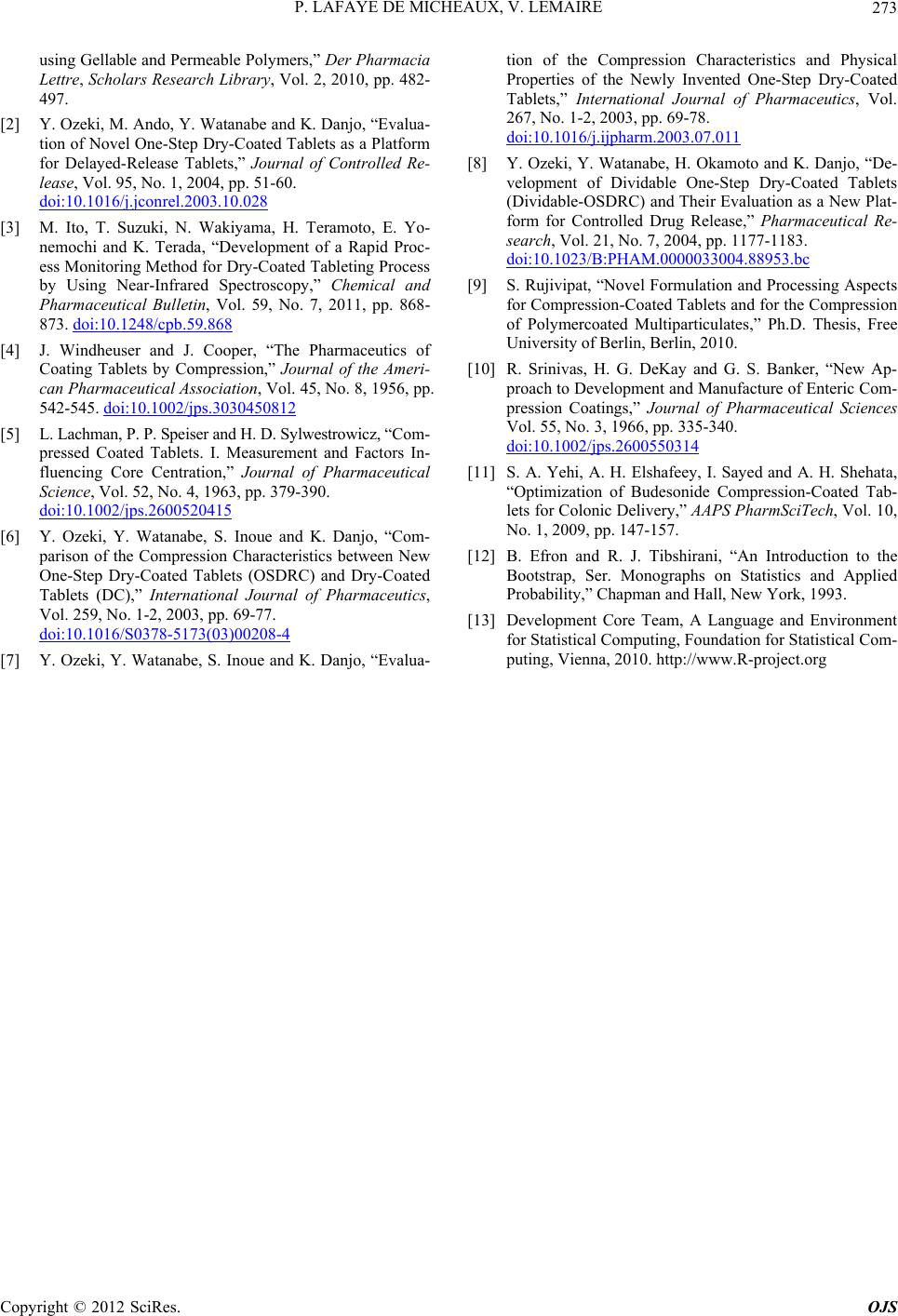
P. LAFAYE DE MICHEAUX, V. LEMAIRE
Copyright © 2012 SciRes. OJS
273
using Gellable and Permeable Polymers,” Der Pharmacia
Lettre, Scholars Research Library, Vol. 2, 2010, pp. 482-
497.
[2] Y. Ozeki, M. Ando, Y. Watanabe and K. Danjo, “Evalua-
tion of Novel One-Step Dry-Coated Tablets as a Platform
for Delayed-Release Tablets,” Journal of Controlled Re-
lease, Vol. 95, No. 1, 2004, pp. 51-60.
doi:10.1016/j.jconrel.2003.10.028
[3] M. Ito, T. Suzuki, N. Wakiyama, H. Teramoto, E. Yo-
nemochi and K. Terada, “Development of a Rapid Proc-
ess Monitoring Method for Dry-Coated Tableting Process
by Using Near-Infrared Spectroscopy,” Chemical and
Pharmaceutical Bulletin, Vol. 59, No. 7, 2011, pp. 868-
873. doi:10.1248/cpb.59.868
[4] J. Windheuser and J. Cooper, “The Pharmaceutics of
Coating Tablets by Compression,” Journal of the Ameri-
can Pharmaceutical Association, Vol. 45, No. 8, 1956, pp.
542-545. doi:10.1002/jps.3030450812
[5] L. Lachman, P. P. Speiser and H. D. Sylwestrowicz, “Com-
pressed Coated Tablets. I. Measurement and Factors In-
fluencing Core Centration,” Journal of Pharmaceutical
Science, Vol. 52, No. 4, 1963, pp. 379-390.
doi:10.1002/jps.2600520415
[6] Y. Ozeki, Y. Watanabe, S. Inoue and K. Danjo, “Com-
parison of the Compression Characteristics between New
One-Step Dry-Coated Tablets (OSDRC) and Dry-Coated
Tablets (DC),” International Journal of Pharmaceutics,
Vol. 259, No. 1-2, 2003, pp. 69-77.
doi:10.1016/S0378-5173(03)00208-4
[7] Y. Ozeki, Y. Watanabe, S. Inoue and K. Danjo, “Evalua-
tion of the Compression Characteristics and Physical
Properties of the Newly Invented One-Step Dry-Coated
Tablets,” International Journal of Pharmaceutics, Vol.
267, No. 1-2, 2003, pp. 69-78.
doi:10.1016/j.ijpharm.2003.07.011
[8] Y. Ozeki, Y. Watanabe, H. Okamoto and K. Danjo, “De-
velopment of Dividable One-Step Dry-Coated Tablets
(Dividable-OSDRC) and Their Evaluation as a New Plat-
form for Controlled Drug Release,” Pharmaceutical Re-
search, Vol. 21, No. 7, 2004, pp. 1177-1183.
doi:10.1023/B:PHAM.0000033004.88953.bc
[9] S. Rujivipat, “Novel Formulation and Processing Aspects
for Compression-Coated Tablets and for the Compression
of Polymercoated Multiparticulates,” Ph.D. Thesis, Free
University of Berlin, Berlin, 2010.
[10] R. Srinivas, H. G. DeKay and G. S. Banker, “New Ap-
proach to Development and Manufacture of Enteric Com-
pression Coatings,” Journal of Pharmaceutical Sciences
Vol. 55, No. 3, 1966, pp. 335-340.
doi:10.1002/jps.2600550314
[11] S. A. Yehi, A. H. Elshafeey, I. Sayed and A. H. Shehata,
“Optimization of Budesonide Compression-Coated Tab-
lets for Colonic Delivery,” AAPS PharmSciTech, Vol. 10,
No. 1, 2009, pp. 147-157.
[12] B. Efron and R. J. Tibshirani, “An Introduction to the
Bootstrap, Ser. Monographs on Statistics and Applied
Probability,” Chapman and Hall, New York, 1993.
[13] Development Core Team, A Language and Environment
for Statistical Computing, Foundation for Statistical Com-
puting, Vienna, 2010. http://www.R-project.org